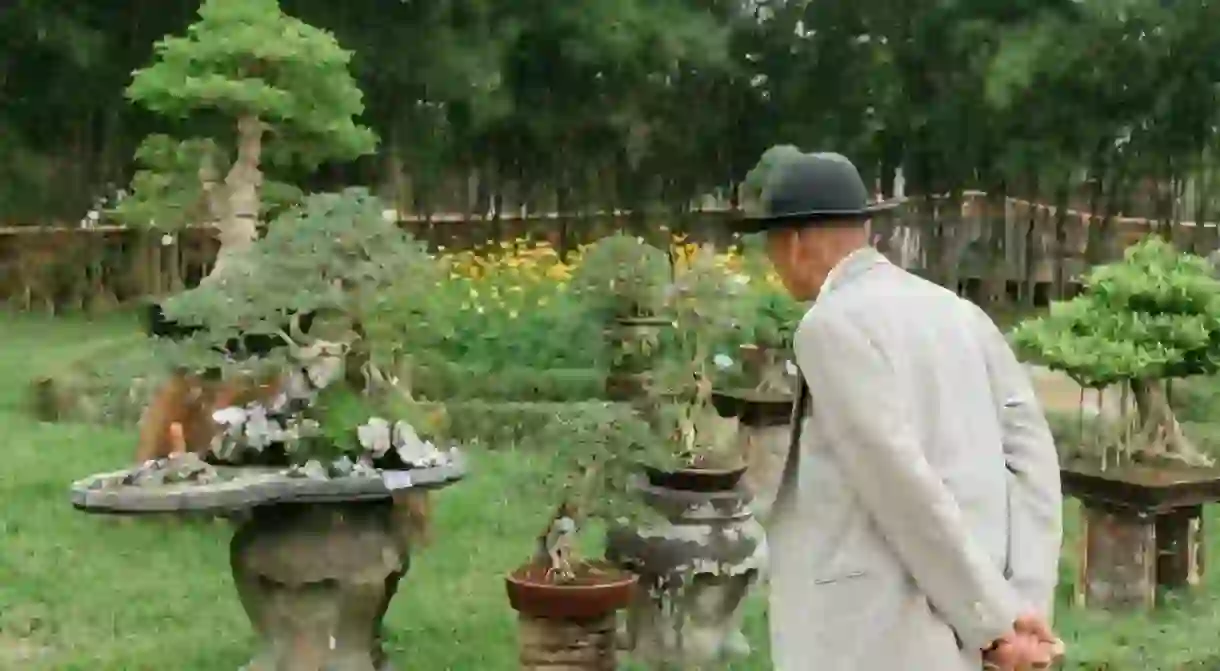Vietnam's Tradition of Beautiful Bonsai Tree Art

Bonsai trees have been carefully cultivated across the world for decades, but this ancient art form originated in Japan over a thousand years ago. This beautiful tradition has made its way to Vietnam, where talented artists meticulously groom each seedling to become a miniature version of their full-grown counterparts. Check out Vietnam’s tradition of Bonsai tree art.

The origins of bonsai art
This thousand-year-old tradition involves the use of several cultivation techniques to grow a seedling that eventually mimics the shape and scale of full-size trees. Artists use methods such as leaf trimming, pruning, defoliation, and wiring (creating the general form of the tree) to achieve its miniature likeness.

Bonsai trees also require dedicated caregivers. The massive size difference between regular trees and bonsai trees affect every aspect of tree biology. Full-sized trees have roots that reach several meters into the ground whereas a bonsai tree is kept in a small pot so the roots must be regularly trimmed. Trees normally grow upwards of five meters and Bonsai trees are obviously much smaller (rarely reaching one meter in height) and so they require regular care. Watering, location, soil, and especially the type of seedlings all play a role in dictating how a bonsai tree will develop.


Not all trees are suitable specimens for bonsai tree development. Some tree species are more popular for having characteristics that make it easier to cultivate a mini-version of it, such as small leaves or needles.


Source specimens for bonsai trees
Bonsai artists can use seedlings, cuttings, or a small tree of a species in order to create a bonsai. In Vietnam, some trees are more desirable than others and can fetch high prices on the market. For this reason, certain trees on Cat Ba island have been targeted for their ability to be successfully cultivated as bonsai trees. This has led to a decrease in habitat for the Cat Ba langur, a rare species of monkey in Vietnam.

The popular tree in question for Vietnamese bonsai growers is the Ficus benjamica, found on Cat Ba island and other areas in the country. Young trees or their stems can sell for $1,000 in bonsai nurseries and as a result locals have been scouring Cat Ba’s island for bonsai source material, to the detriment of the endangered langur, prompting local conservation efforts and education to prevent mass deforestation.


Bonsai festivals
This art form is popular in Vietnam and there are two large festivals in one of Vietnam’s oldest cities to showcase artists’ work. Hue hosts one large-scale exhibition for local artists over the Tet holiday and another during the annual Hue Festival. Vietnamese artists from all over Vietnam come to the Hue Festival to display the results of their fine cultivation techniques.



Artists also make miniature living landscapes called Hòn Nam Bộ in Vietnamese. This tradition embraces the similar bonsai traditions but allows for more creativity when composing the landscapes.


Hòn Nam Bộ emphasises the natural landscape. Bonsai trees are shaped by the hand of their grower, but in landscape scenes the trees look more affected by natural surroundings rather than careful cultivation by the artist.





Green Hue Bonsai Club
Culture Trip met with Mr. Nguyễn Công Cứ, a 72-year-old bonsai enthusiast and member of the Green Hue Bonsai Club. Mr. Cứ began bonsai tree planting in 1981 and told Culture Trip his inspiration came from his visits to nearby royal tombs and pagodas in Hue, where there were many decorative bonsai trees and landscapes.


Mr. Cứ began his bonsai creations using different specimens of source material such as a cutting, seedling, or a small tree of a species suitable for bonsai development. His son is also a bonsai artist and they both have a spacious area at their home dedicated to bonsai art. Each bonsai tree can take two to three years of cultivation before it is mature and can be valued between 20-40 million VND ($2,000-4,000 USD)!

The bonsai tradition continues to attract new artists and enthusiasts in Vietnam. If you’re in town to catch a glimpse of these fascinating creations, check out one of the two festivals held each year in Hue or head to one of the many bonsai gardens in Saigon.














